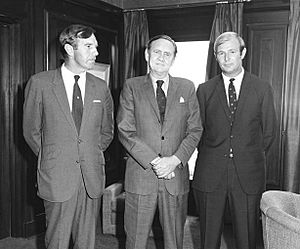Ian Sinclair facts for kids
Quick facts for kids
Ian Sinclair
|
|||||||||||||||||||||||||||||||||||||||||||||||||||||||||||||||||||||||
|---|---|---|---|---|---|---|---|---|---|---|---|---|---|---|---|---|---|---|---|---|---|---|---|---|---|---|---|---|---|---|---|---|---|---|---|---|---|---|---|---|---|---|---|---|---|---|---|---|---|---|---|---|---|---|---|---|---|---|---|---|---|---|---|---|---|---|---|---|---|---|---|

Sinclair in 1970
|
|||||||||||||||||||||||||||||||||||||||||||||||||||||||||||||||||||||||
| 23rd Speaker of the Australian House of Representatives | |||||||||||||||||||||||||||||||||||||||||||||||||||||||||||||||||||||||
| In office 4 March 1998 – 31 August 1998 |
|||||||||||||||||||||||||||||||||||||||||||||||||||||||||||||||||||||||
| Preceded by | Bob Halverson | ||||||||||||||||||||||||||||||||||||||||||||||||||||||||||||||||||||||
| Succeeded by | Neil Andrew | ||||||||||||||||||||||||||||||||||||||||||||||||||||||||||||||||||||||
| Leader of the National Party | |||||||||||||||||||||||||||||||||||||||||||||||||||||||||||||||||||||||
| In office 17 January 1984 – 9 May 1989 |
|||||||||||||||||||||||||||||||||||||||||||||||||||||||||||||||||||||||
| Deputy | Ralph Hunt Bruce Lloyd |
||||||||||||||||||||||||||||||||||||||||||||||||||||||||||||||||||||||
| Preceded by | Doug Anthony | ||||||||||||||||||||||||||||||||||||||||||||||||||||||||||||||||||||||
| Succeeded by | Charles Blunt | ||||||||||||||||||||||||||||||||||||||||||||||||||||||||||||||||||||||
| Deputy Leader of the National Party | |||||||||||||||||||||||||||||||||||||||||||||||||||||||||||||||||||||||
| In office 2 February 1971 – 17 January 1984 |
|||||||||||||||||||||||||||||||||||||||||||||||||||||||||||||||||||||||
| Leader | Doug Anthony | ||||||||||||||||||||||||||||||||||||||||||||||||||||||||||||||||||||||
| Preceded by | Doug Anthony | ||||||||||||||||||||||||||||||||||||||||||||||||||||||||||||||||||||||
| Succeeded by | Ralph Hunt | ||||||||||||||||||||||||||||||||||||||||||||||||||||||||||||||||||||||
|
|||||||||||||||||||||||||||||||||||||||||||||||||||||||||||||||||||||||
|
|||||||||||||||||||||||||||||||||||||||||||||||||||||||||||||||||||||||
| Member of the Australian Parliament for New England | |||||||||||||||||||||||||||||||||||||||||||||||||||||||||||||||||||||||
| In office 30 November 1963 – 31 August 1998 |
|||||||||||||||||||||||||||||||||||||||||||||||||||||||||||||||||||||||
| Preceded by | David Drummond | ||||||||||||||||||||||||||||||||||||||||||||||||||||||||||||||||||||||
| Succeeded by | Stuart St. Clair | ||||||||||||||||||||||||||||||||||||||||||||||||||||||||||||||||||||||
| Member of the Legislative Council of New South Wales |
|||||||||||||||||||||||||||||||||||||||||||||||||||||||||||||||||||||||
| In office 23 April 1961 – 24 October 1963 |
|||||||||||||||||||||||||||||||||||||||||||||||||||||||||||||||||||||||
| Succeeded by | Alexander Alam | ||||||||||||||||||||||||||||||||||||||||||||||||||||||||||||||||||||||
| Personal details | |||||||||||||||||||||||||||||||||||||||||||||||||||||||||||||||||||||||
| Born |
Ian McCahon Sinclair
10 June 1929 Sydney, New South Wales, Australia |
||||||||||||||||||||||||||||||||||||||||||||||||||||||||||||||||||||||
| Political party | National | ||||||||||||||||||||||||||||||||||||||||||||||||||||||||||||||||||||||
| Spouses |
Margaret Tarrant
(m. 1956; died 1967)Rosemary Fenton
(m. 1970) |
||||||||||||||||||||||||||||||||||||||||||||||||||||||||||||||||||||||
| Relations | Peter King (son-in-law) | ||||||||||||||||||||||||||||||||||||||||||||||||||||||||||||||||||||||
| Children | 4 | ||||||||||||||||||||||||||||||||||||||||||||||||||||||||||||||||||||||
| Occupation | Grazier | ||||||||||||||||||||||||||||||||||||||||||||||||||||||||||||||||||||||
Ian McCahon Sinclair (born 10 June 1929) is an Australian former politician. He was a Member of Parliament for 35 years. He also led the National Party from 1984 to 1989.
Mr. Sinclair held many important roles in government. He was a minister or a key opposition member for most of the time from 1965 to 1989. Later, he became the Speaker of the House of Representatives in 1998.
He was born in Sydney and studied law. He later became a farmer near Tamworth. Mr. Sinclair was first elected to parliament in 1963. He joined the government as a minister in 1965. He served under several Prime Ministers, including Harold Holt, John McEwen, John Gorton, and William McMahon.
In 1971, he became the deputy leader of his party. He was a senior member of the Fraser government. During this time, he was Minister for Primary Industry (1975–1979), Minister for Communications (1980–1982), and Minister for Defence (1982–1983).
In 1984, Mr. Sinclair became the leader of the National Party. He led the party in two federal elections. He was replaced as leader in 1989. From 1990 until he retired in 1998, he was the Father of the Parliament. This title goes to the longest-serving member. He spent his last six months in parliament as Speaker. He is the only person from his party to have held this position.
Mr. Sinclair also helped lead the 1998 constitutional convention. This meeting discussed if Australia should become a republic. He is one of the last surviving Australian members of the Privy Council of the United Kingdom. This means he can use the title "The Right Honourable."
Contents
Early Life and Education
Ian Sinclair was born in Sydney, Australia, on 10 June 1929. His parents were Gertrude Hazel and George McCahon Sinclair. His father was an accountant and was involved in local government and church activities.
Ian went to Knox Grammar School. After that, he studied at the University of Sydney. He earned degrees in Arts in 1949 and Law in 1952. He also served in the Citizen Air Force for a few years.
Instead of practicing law, Mr. Sinclair decided to become a farmer. He bought a property near Bendemeer. He also became the managing director of the Sinclair Pastoral Company. He was also a director for a farmers' co-operative.
Mr. Sinclair married Margaret Anne Tarrant in 1956. They had three children. After Margaret passed away, he married Rosemary Fenton in 1970. They had one son together.
Political Journey
Starting in Politics
Mr. Sinclair began his political career in the Country Party. In 1961, he was appointed to the New South Wales Legislative Council. This is a part of the state parliament.
He later resigned from this role to run for the House of Representatives. This is part of the federal parliament. In the 1963 federal election, he won the seat of Division of New England. He kept this seat for his party.
Serving as a Government Minister
In 1965, Mr. Sinclair became the Minister for Social Services in the Menzies Government. This was his first role as a government minister.
In 1968, he became the Minister for Shipping and Transport. This role involved managing Australia's shipping and transport systems.
In 1971, the Country Party leader, John McEwen, retired. Doug Anthony became the new leader, and Mr. Sinclair was elected as his deputy. He then became the Minister for Primary Industry. This job focused on farming and agriculture.
After the Whitlam Labor government, Mr. Sinclair returned to being Minister for Primary Industry in 1975. This was during the Fraser government. In 1977, he was appointed to the Privy Council of the United Kingdom. This is a special group of advisors to the Queen.
In August 1980, Mr. Sinclair became the Minister for Special Trade Representations. Later, after the 1980 election, he was made Minister for Communications. This role involved overseeing communication services.
His last ministerial role was Minister for Defence in May 1982. He held this position until the government lost the 1983 election.
Leading the Party
In January 1984, Mr. Sinclair was elected as the leader of the National Party. He took over from Doug Anthony. He led the party in the 1984 and 1987 federal elections.
During his time as leader, he discussed important national issues. He believed in the importance of the National Party's unique views. He also talked about Australia's role in the Pacific region. He suggested forming a Pacific trade bloc to help protect trade interests.
In 1989, Charles Blunt replaced Mr. Sinclair as party leader. Mr. Sinclair tried to regain the leadership in 1990 but was unsuccessful. He then moved to the back bench, continuing to serve as a Member of Parliament.
Later Years in Parliament and Speaker Role
By 1993, Mr. Sinclair was the Father of the House. This means he was the longest-serving member of the House. He was also the last sitting MP who had served with Prime Minister Robert Menzies.
In 1997, Prime Minister Howard appointed Mr. Sinclair as co-chairman of the Constitutional Convention. This convention discussed if Australia should become a republic. Mr. Sinclair was a strong supporter of Australia remaining a monarchy.
Mr. Sinclair announced he would retire from Parliament in 1998. However, when the Speaker, Bob Halverson, suddenly resigned, Mr. Sinclair was elected to replace him. He became the first National Party member to hold the Speaker's position. He served as Speaker for the last six months of his term. He was known for his experience and assertive style in this role.
He retired from Parliament at the 1998 election. At that time, he was the last parliamentary member who had served in the Menzies, Holt, and Gorton governments.
Life After Politics
After leaving politics, Mr. Sinclair continued to be involved in public service. In January 2001, he received the Companion of the Order of Australia (AC). This is a high honor for his service to Australia.
He served as the President of AUSTCARE, an organization that provides international aid. He also became the first chairman of the Foundation for Rural and Regional Renewal (FRRR) in 2000. This non-profit group gives grants to help regional communities. He retired from this role in 2019.
Mr. Sinclair also served as the Honorary President of the Scout Association of Australia, New South Wales Branch. He retired from this role in 2019 and received a special award from the Scouts in 2020.
Images for kids
-
Sinclair addressing an audience in Darwin, Northern Territory, in 1970



